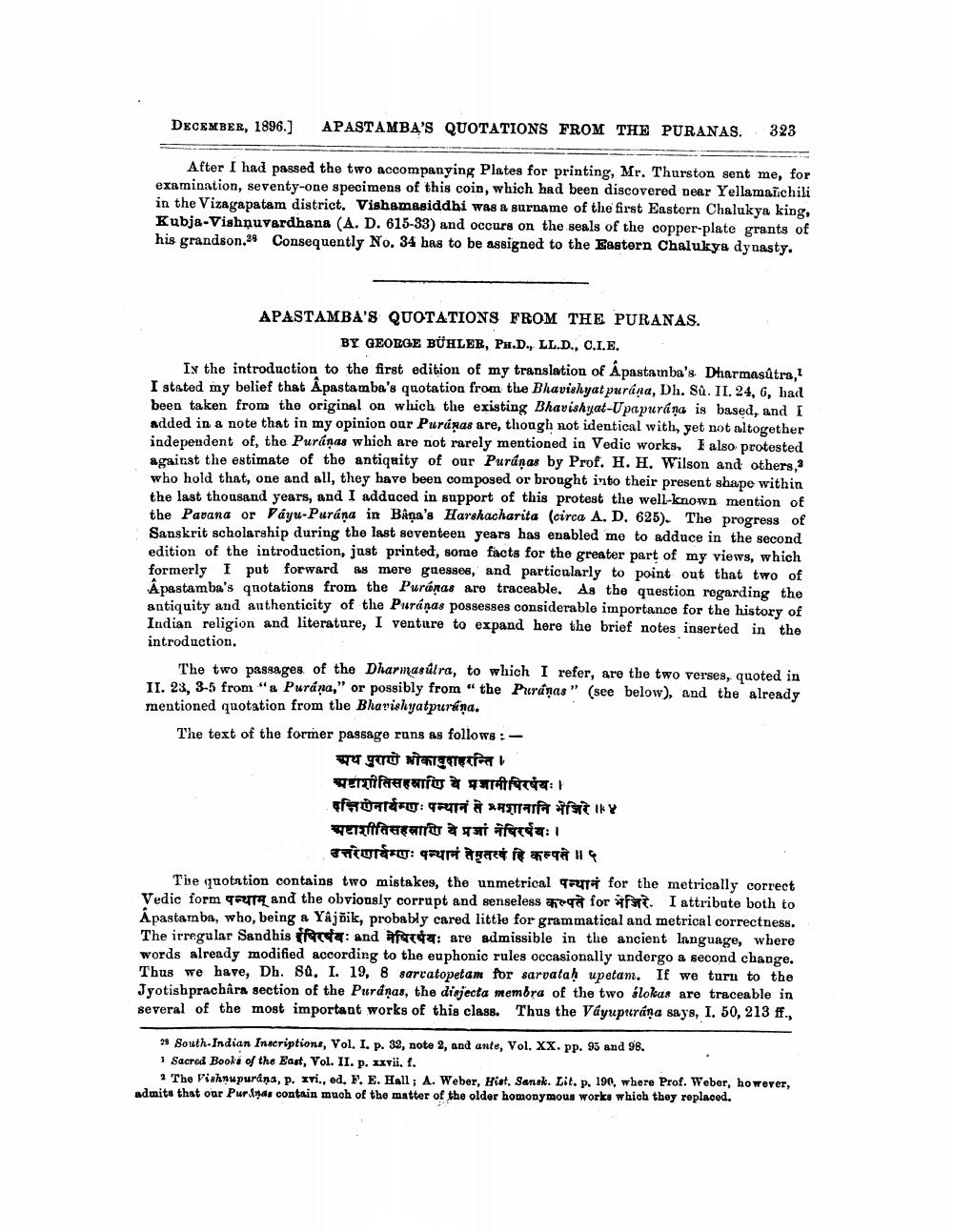________________
DECEMBER, 1896.]
APASTAMBA'S QUOTATIONS FROM THE PURANAS. 323
After I had passed the two accompanying Plates for printing, Mr. Thurston sent me, for examination, seventy-one specimens of this coin, which had been discovered near Yellamanchili in the Vizagapatam district. Vishamasiddhi was a surname of the first Eastern Chalukya king, Kubja-Vishnuvardhana (A. D. 615-33) and occurs on the seals of the copper-plate grants of his grandson.29 Consequently No. 34 has to be assigned to the Eastern Chalukya dynasty.
APASTAMBA'S QUOTATIONS FROM THE PURANAS.
BY GEORGE BÜHLER, PH.D., LL.D., C.I.E.
Is the introduction to the first edition of my translation of Apastamba's. Dharmasûtra,1 I stated my belief that Apastamba's quotation from the Bhavishyat purana, Dh. Sû. II. 24, 6, had been taken from the original on which the existing Bhavishyat-Upapurána is based, and I added in a note that in my opinion our Puranas are, though not identical with, yet not altogether independent of, the Puranas which are not rarely mentioned in Vedic works. I also protested against the estimate of the antiquity of our Puranas by Prof. H. H. Wilson and others,3 who hold that, one and all, they have been composed or brought into their present shape within the last thousand years, and I adduced in support of this protest the well-known mention of the Pavana or Váyu-Purána in Bana's Harshacharita (circa A. D. 625). The progress of Sanskrit scholarship during the last seventeen years has enabled me to adduce in the second edition of the introduction, just printed, some facts for the greater part of my views, which formerly I put forward as mere guesses, and particularly to point out that two of Apastamba's quotations from the Puranas are traceable. As the question regarding the antiquity and authenticity of the Puráņas possesses considerable importance for the history of Indian religion and literature, I venture to expand here the brief notes inserted in the introduction.
The two passages of the Dharmasútra, to which I refer, are the two verses, quoted in II. 23, 3-5 from "a Purána," or possibly from "the Puranas" (see below), and the already mentioned quotation from the Bhavishyatpurana.
The text of the former passage runs as follows:
अथ पुराणे श्रीकावुदाहरन्ति । अष्टाशीतिसहस्राणि ये प्रजामीभिरर्षयः ।
दक्षिणेनार्यः पन्थानं से श्मशानानि भेजिरे ॥ ४ अष्टाशीतिसहस्राणि ये प्रजां नेषिरर्षयः ।
उत्तरेणार्वणः पन्थानं तेमृतत्वं हि कल्पते ॥ ५
The quotation contains two mistakes, the unmetrical for the metrically correct Vedic form पन्थाम् and the obviously corrupt and senseless कल्पते for भेजिरे. I attribute both to Apastamba, who, being a Yâjnik, probably cared little for grammatical and metrical correctness. The irregular Sandhis fra: and fada: are admissible in the ancient language, where words already modified according to the euphonic rules occasionally undergo a second change. Thus we have, Dh. Sû. I. 19, 8 sarvatopetam for sarvataḥ upetam. If we turn to the Jyotishprachâra section of the Puranas, the disjecta membra of the two slokas are traceable in several of the most important works of this class. Thus the Vayupurana says, I. 50, 213 ff.,
28 South-Indian Inscriptions, Vol. I. p. 32, note 2, and ante, Vol. XX. pp. 95 and 98.
1 Sacred Books of the East, Vol. II. p. xxvii. f.
2 The Vishnupurana, p. xvi., ed. F. E. Hall; A. Weber, Hist. Sansk. Lit. p. 190, where Prof. Weber, however, admits that our Purinas contain much of the matter of the older homonymous works which they replaced.




